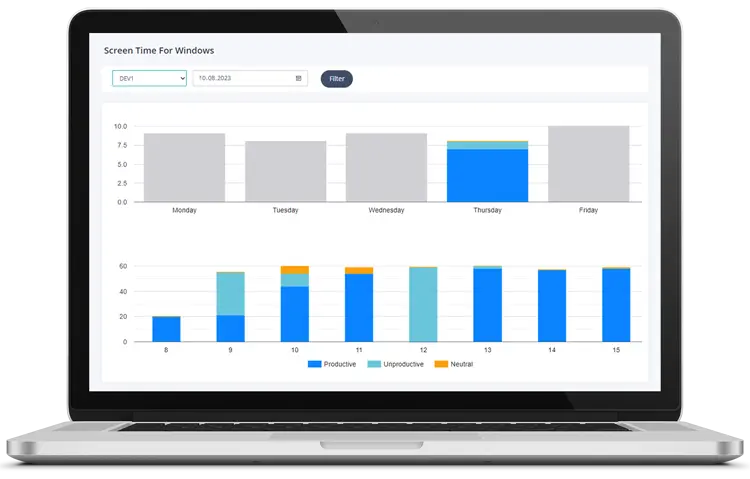Enhancing Workforce Analytics for Optimal Employee Performance
Workforce analytics is a powerful tool for optimizing employee performance, offering organizations insights into various productivity and engagement metrics. By tracking these key metrics, companies can identify areas needing improvement and develop targeted strategies to boost overall performance. Let's explore the primary metrics that workforce analytics track and how they contribute to optimizing employee performance, including the role of time tracking with screenshots.
Productivity Metrics
-
Output Per Employee:
Measuring the output per employee involves tracking the amount of work produced by each individual within a specified period. This could be the number of units produced, sales made, or tasks completed. For example, a sales team might be evaluated based on the number of closed deals per month. High output indicates strong productivity, while lower output may signal the need for additional support or training.
-
Project Completion Rates:
Tracking how many projects are completed on time provides insights into team efficiency. This metric helps identify bottlenecks in workflows and areas where resources may need to be reallocated. For instance, if a project consistently misses deadlines, it might indicate issues in planning or execution that need addressing.
Employee Engagement Metrics
-
Satisfaction Scores:
Employee satisfaction surveys offer valuable data on how employees feel about their work environment, management, and overall job satisfaction. High satisfaction scores typically correlate with higher engagement and productivity. Conversely, low scores can indicate underlying issues that may affect performance and retention.
-
Retention Rates:
Monitoring retention rates helps organizations understand employee turnover. High turnover can be costly and disruptive, indicating potential problems with job satisfaction, workplace culture, or career development opportunities. By analyzing retention rates, companies can implement strategies to improve employee loyalty and reduce turnover.
-
Participation in Initiatives:
Tracking employee participation in company initiatives, such as training programs or wellness activities, provides insights into engagement levels. High participation rates suggest a committed and motivated workforce, while low participation may highlight areas where more encouragement or better communication is needed.
Performance Reviews and Feedback
-
Goal Attainment:
Regular performance reviews that track goal attainment are essential for evaluating individual performance. These reviews provide a structured way to assess whether employees meet their objectives, offering opportunities for feedback and development. For example, an employee might be reviewed on their ability to achieve quarterly sales targets, with feedback provided to help them improve.
Attendance and Punctuality
-
Reliability and Commitment:
Monitoring attendance and punctuality metrics offers insights into employee reliability and commitment. High levels of absenteeism or frequent tardiness can disrupt productivity and indicate disengagement or personal issues. By tracking these metrics, companies can address potential problems early and support employees in maintaining consistent attendance.
Skills Development Metrics
-
Training Participation:
Tracking participation in training programs helps measure the effectiveness of skills development initiatives. This metric indicates how many employees are taking advantage of learning opportunities, which is crucial for continuous improvement and career growth. For example, a high participation rate in a new software training program suggests that employees are eager to enhance their skills and contribute more effectively to their roles.
-
Skill Acquisition:
Metrics related to skill acquisition, such as certifications earned or new competencies developed, help evaluate the impact of training programs. These metrics ensure that employees are not only participating in training but also gaining valuable skills that improve their performance.
-
Time Tracking With Screenshots
Incorporating time tracking with screenshots into workforce analytics provides an additional layer of insight into employee performance. This method involves capturing screenshots at regular intervals to verify the time spent on tasks and ensure employees are focused on their work. It helps identify productivity patterns, detect potential distractions, and verify the accuracy of reported working hours.
For instance, time tracking with screenshots can reveal if an employee is spending excessive time on non-work-related activities or struggling with task prioritization. By analyzing these screenshots alongside other metrics, managers can provide more targeted support and feedback, ultimately enhancing productivity and performance.
How MonitUp Solves These Challenges
MonitUp provides a comprehensive solution to track these essential workforce metrics effectively. With MonitUp, you can:
- Monitor Productivity: Track output per employee and project completion rates effortlessly.
- Enhance Engagement: Measure satisfaction scores, retention rates, and participation in company initiatives.
- Streamline Performance Reviews: Efficiently track goal attainment and performance feedback.
- Improve Attendance Tracking: Monitor attendance and punctuality to ensure reliability.
- Facilitate Skills Development: Keep track of training participation and skill acquisition.
- Implement Time Tracking With Screenshots: Use screenshots to verify time spent on tasks and ensure productivity.
MonitUp helps organizations gain valuable insights into employee performance and implement targeted strategies to optimize productivity, engagement, and overall performance.
Ready to enhance your workforce analytics and boost employee performance? Sign up for MonitUp now!
